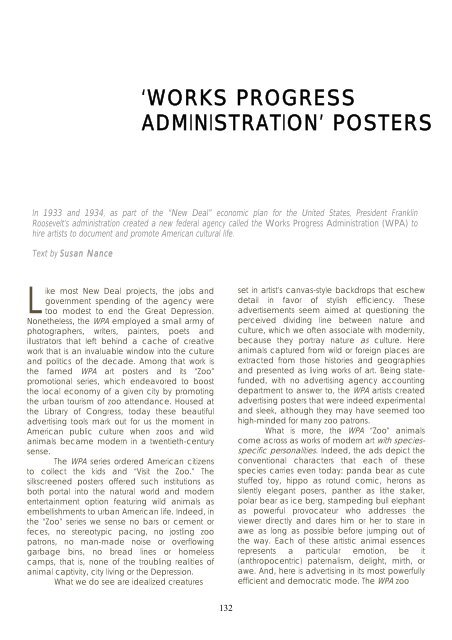Marketing Animals - Antennae The Journal of Nature in Visual Culture
Marketing Animals - Antennae The Journal of Nature in Visual Culture
Marketing Animals - Antennae The Journal of Nature in Visual Culture
You also want an ePaper? Increase the reach of your titles
YUMPU automatically turns print PDFs into web optimized ePapers that Google loves.
L<br />
ike most New Deal projects, the jobs and<br />
government spend<strong>in</strong>g <strong>of</strong> the agency were<br />
too modest to end the Great Depression.<br />
Nonetheless, the WPA employed a small army <strong>of</strong><br />
photographers, writers, pa<strong>in</strong>ters, poets and<br />
illustrators that left beh<strong>in</strong>d a cache <strong>of</strong> creative<br />
work that is an <strong>in</strong>valuable w<strong>in</strong>dow <strong>in</strong>to the culture<br />
and politics <strong>of</strong> the decade. Among that work is<br />
the famed WPA art posters and its “Zoo”<br />
promotional series, which endeavored to boost<br />
the local economy <strong>of</strong> a given city by promot<strong>in</strong>g<br />
the urban tourism <strong>of</strong> zoo attendance. Housed at<br />
the Library <strong>of</strong> Congress, today these beautiful<br />
advertis<strong>in</strong>g tools mark out for us the moment <strong>in</strong><br />
American public culture when zoos and wild<br />
animals became modern <strong>in</strong> a twentieth-century<br />
sense.<br />
<strong>The</strong> WPA series ordered American citizens<br />
to collect the kids and “Visit the Zoo.” <strong>The</strong><br />
silkscreened posters <strong>of</strong>fered such <strong>in</strong>stitutions as<br />
both portal <strong>in</strong>to the natural world and modern<br />
enterta<strong>in</strong>ment option featur<strong>in</strong>g wild animals as<br />
embellishments to urban American life. Indeed, <strong>in</strong><br />
the “Zoo” series we sense no bars or cement or<br />
feces, no stereotypic pac<strong>in</strong>g, no jostl<strong>in</strong>g zoo<br />
patrons, no man-made noise or overflow<strong>in</strong>g<br />
garbage b<strong>in</strong>s, no bread l<strong>in</strong>es or homeless<br />
camps, that is, none <strong>of</strong> the troubl<strong>in</strong>g realities <strong>of</strong><br />
animal captivity, city liv<strong>in</strong>g or the Depression.<br />
What we do see are idealized creatures<br />
‘WORKS PROGRESS<br />
ADMINISTRATION’ POSTERS<br />
In 1933 and 1934, as part <strong>of</strong> the “New Deal” economic plan for the United States, President Frankl<strong>in</strong><br />
Roosevelt’s adm<strong>in</strong>istration created a new federal agency called the Works Progress Adm<strong>in</strong>istration (WPA) to<br />
hire artists to document and promote American cultural life.<br />
Text by Susan Nance<br />
132<br />
set <strong>in</strong> artist’s canvas-style backdrops that eschew<br />
detail <strong>in</strong> favor <strong>of</strong> stylish efficiency. <strong>The</strong>se<br />
advertisements seem aimed at question<strong>in</strong>g the<br />
perceived divid<strong>in</strong>g l<strong>in</strong>e between nature and<br />
culture, which we <strong>of</strong>ten associate with modernity,<br />
because they portray nature as culture. Here<br />
animals captured from wild or foreign places are<br />
extracted from those histories and geographies<br />
and presented as liv<strong>in</strong>g works <strong>of</strong> art. Be<strong>in</strong>g statefunded,<br />
with no advertis<strong>in</strong>g agency account<strong>in</strong>g<br />
department to answer to, the WPA artists created<br />
advertis<strong>in</strong>g posters that were <strong>in</strong>deed experimental<br />
and sleek, although they may have seemed too<br />
high-m<strong>in</strong>ded for many zoo patrons.<br />
What is more, the WPA “Zoo” animals<br />
come across as works <strong>of</strong> modern art with speciesspecific<br />
personalities. Indeed, the ads depict the<br />
conventional characters that each <strong>of</strong> these<br />
species carries even today: panda bear as cute<br />
stuffed toy, hippo as rotund comic, herons as<br />
silently elegant posers, panther as lithe stalker,<br />
polar bear as ice berg, stamped<strong>in</strong>g bull elephant<br />
as powerful provocateur who addresses the<br />
viewer directly and dares him or her to stare <strong>in</strong><br />
awe as long as possible before jump<strong>in</strong>g out <strong>of</strong><br />
the way. Each <strong>of</strong> these artistic animal essences<br />
represents a particular emotion, be it<br />
(anthropocentric) paternalism, delight, mirth, or<br />
awe. And, here is advertis<strong>in</strong>g <strong>in</strong> its most powerfully<br />
efficient and democratic mode. <strong>The</strong> WPA zoo












